Workplace Student Support Requirements: A Model-Based Analysis
VerifiedAdded on 2023/06/08
|14
|1333
|458
Presentation
AI Summary
This presentation provides a detailed analysis of the current and proposed student support requirements in a healthcare workplace, focusing on clinical supervision models. It discusses the rationale for supervision, different types of clinical supervision, and the characteristics of the clinical mentoring model. The presentation outlines the strengths of the mentorship model, such as providing mental and professional support, facilitating information sharing, and offering opportunities for clinical observation. It also addresses the limitations, including the lack of direct assessment and potential for mentors to be unapproachable. The conclusion emphasizes the importance of clinical supervision in managing student needs and highlights the benefits of mentoring in supporting student growth within their practice. This resource is available for students on Desklib, a platform offering a wide range of study tools and solved assignments.

Current and proposed
student support
requirements in the
workplace
A detailed analysis
student support
requirements in the
workplace
A detailed analysis
Paraphrase This Document
Need a fresh take? Get an instant paraphrase of this document with our AI Paraphraser
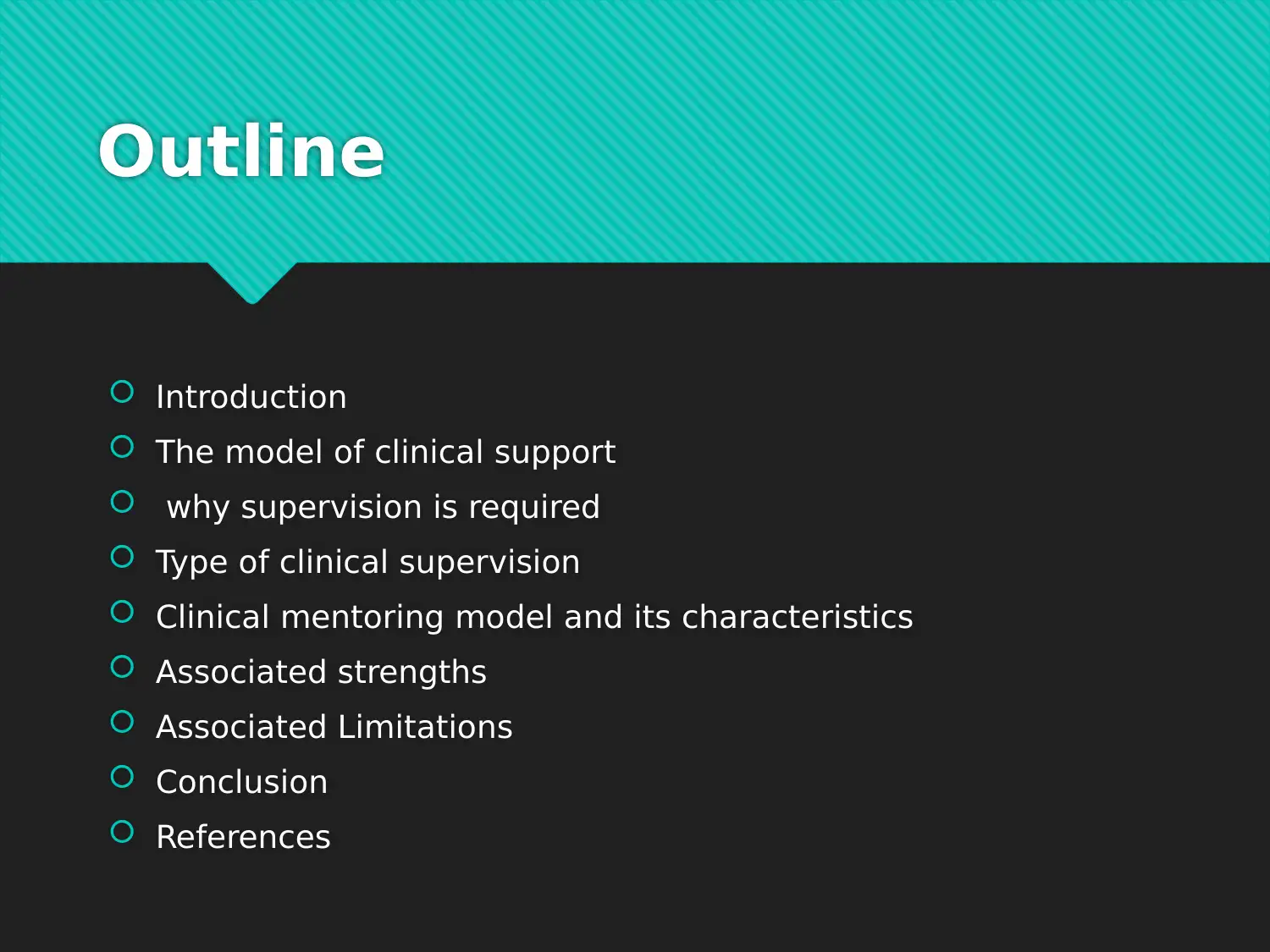
Outline
Introduction
The model of clinical support
why supervision is required
Type of clinical supervision
Clinical mentoring model and its characteristics
Associated strengths
Associated Limitations
Conclusion
References
Introduction
The model of clinical support
why supervision is required
Type of clinical supervision
Clinical mentoring model and its characteristics
Associated strengths
Associated Limitations
Conclusion
References
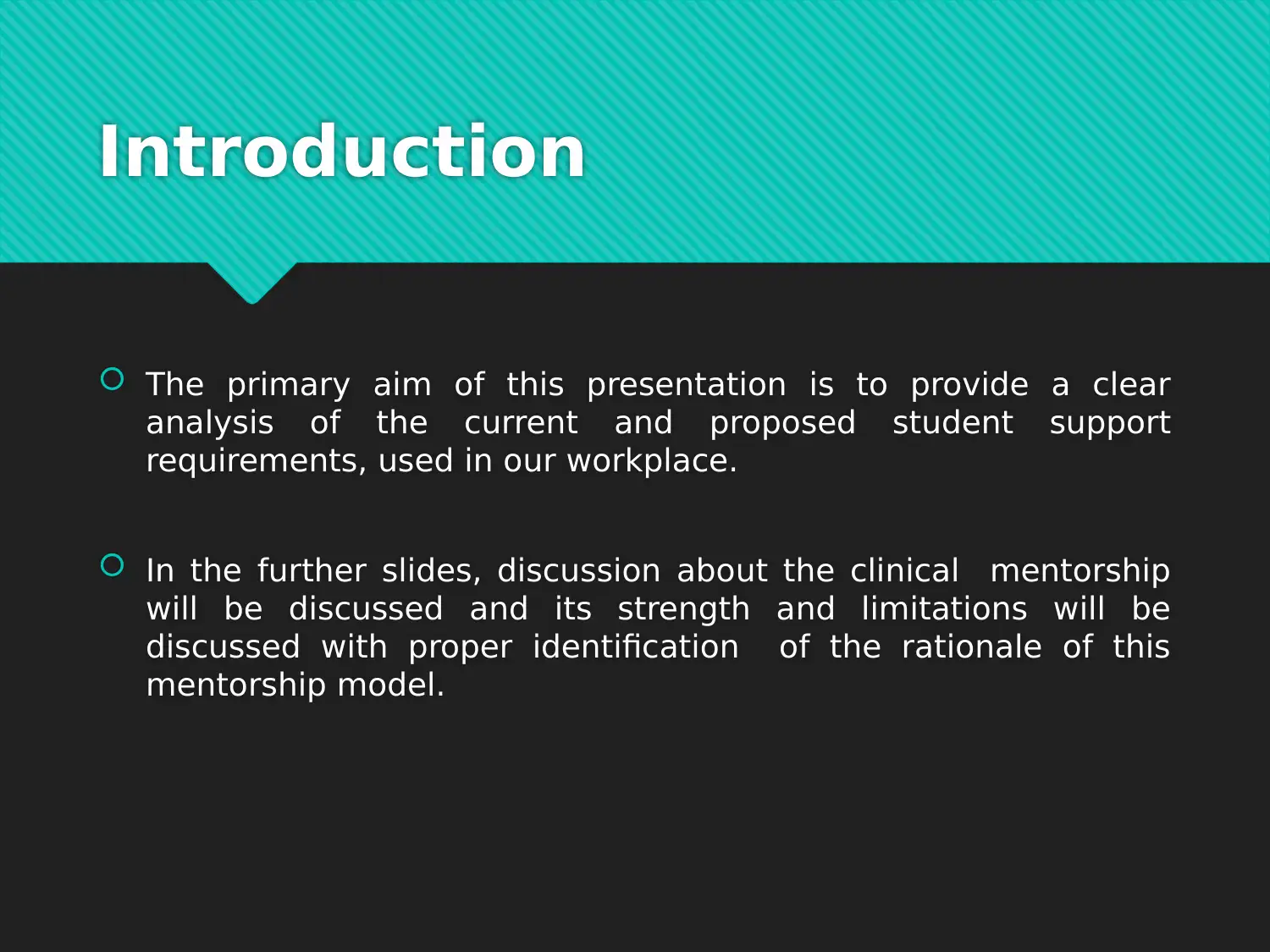
Introduction
The primary aim of this presentation is to provide a clear
analysis of the current and proposed student support
requirements, used in our workplace.
In the further slides, discussion about the clinical mentorship
will be discussed and its strength and limitations will be
discussed with proper identification of the rationale of this
mentorship model.
The primary aim of this presentation is to provide a clear
analysis of the current and proposed student support
requirements, used in our workplace.
In the further slides, discussion about the clinical mentorship
will be discussed and its strength and limitations will be
discussed with proper identification of the rationale of this
mentorship model.
⊘ This is a preview!⊘
Do you want full access?
Subscribe today to unlock all pages.

Trusted by 1+ million students worldwide
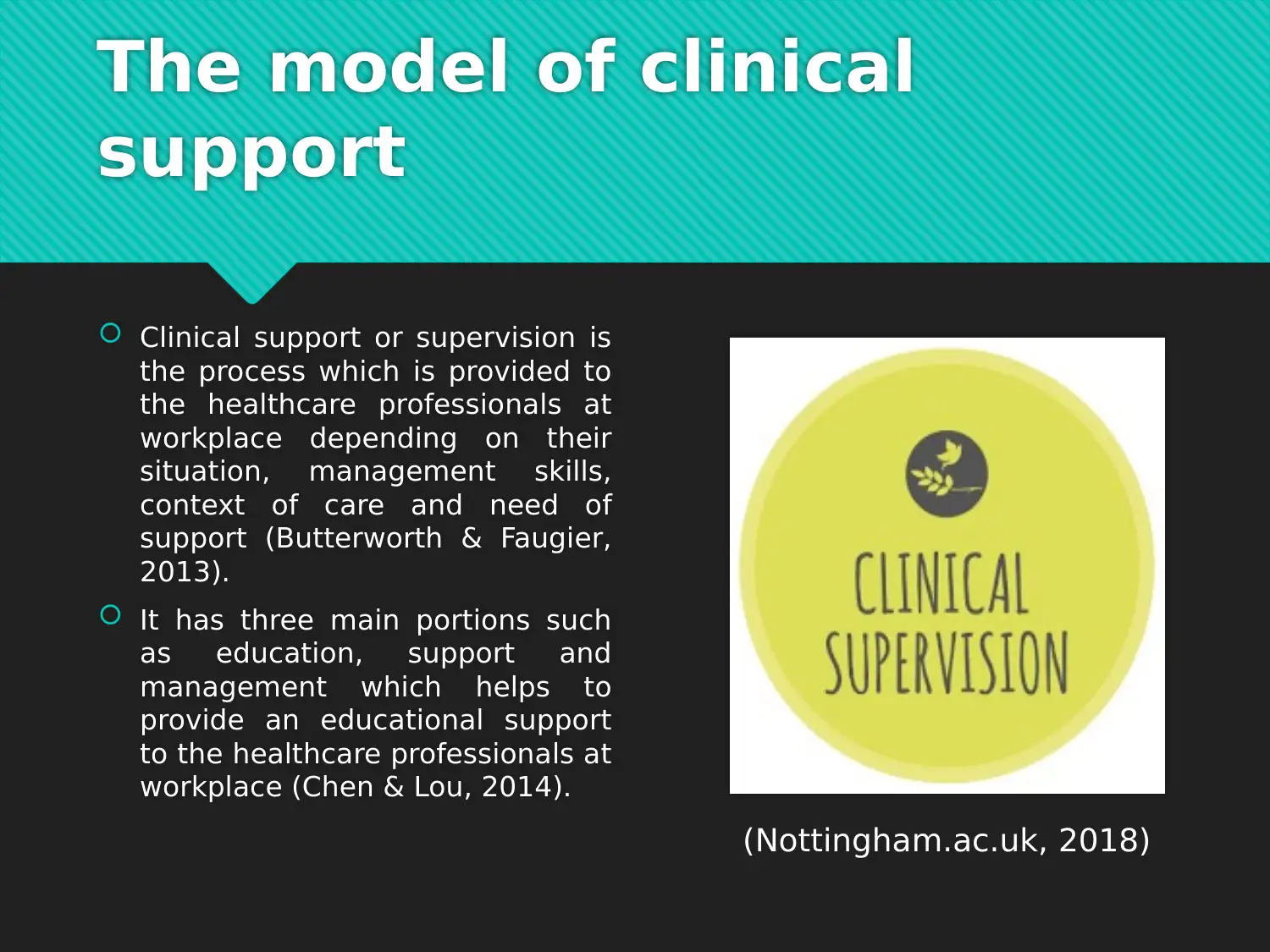
The model of clinical
support
Clinical support or supervision is
the process which is provided to
the healthcare professionals at
workplace depending on their
situation, management skills,
context of care and need of
support (Butterworth & Faugier,
2013).
It has three main portions such
as education, support and
management which helps to
provide an educational support
to the healthcare professionals at
workplace (Chen & Lou, 2014).
(Nottingham.ac.uk, 2018)
support
Clinical support or supervision is
the process which is provided to
the healthcare professionals at
workplace depending on their
situation, management skills,
context of care and need of
support (Butterworth & Faugier,
2013).
It has three main portions such
as education, support and
management which helps to
provide an educational support
to the healthcare professionals at
workplace (Chen & Lou, 2014).
(Nottingham.ac.uk, 2018)
Paraphrase This Document
Need a fresh take? Get an instant paraphrase of this document with our AI Paraphraser
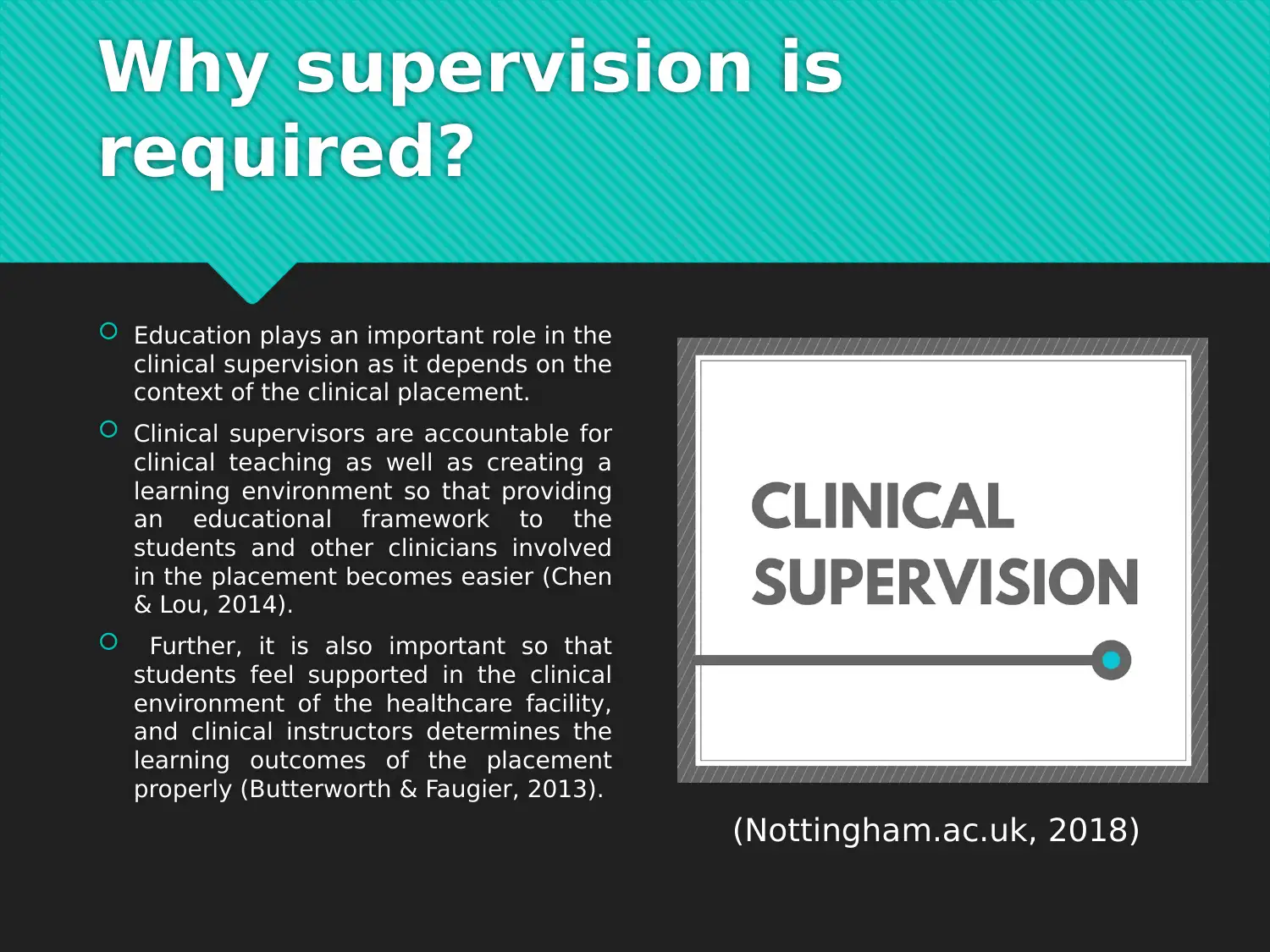
Why supervision is
required?
Education plays an important role in the
clinical supervision as it depends on the
context of the clinical placement.
Clinical supervisors are accountable for
clinical teaching as well as creating a
learning environment so that providing
an educational framework to the
students and other clinicians involved
in the placement becomes easier (Chen
& Lou, 2014).
Further, it is also important so that
students feel supported in the clinical
environment of the healthcare facility,
and clinical instructors determines the
learning outcomes of the placement
properly (Butterworth & Faugier, 2013).
(Nottingham.ac.uk, 2018)
required?
Education plays an important role in the
clinical supervision as it depends on the
context of the clinical placement.
Clinical supervisors are accountable for
clinical teaching as well as creating a
learning environment so that providing
an educational framework to the
students and other clinicians involved
in the placement becomes easier (Chen
& Lou, 2014).
Further, it is also important so that
students feel supported in the clinical
environment of the healthcare facility,
and clinical instructors determines the
learning outcomes of the placement
properly (Butterworth & Faugier, 2013).
(Nottingham.ac.uk, 2018)
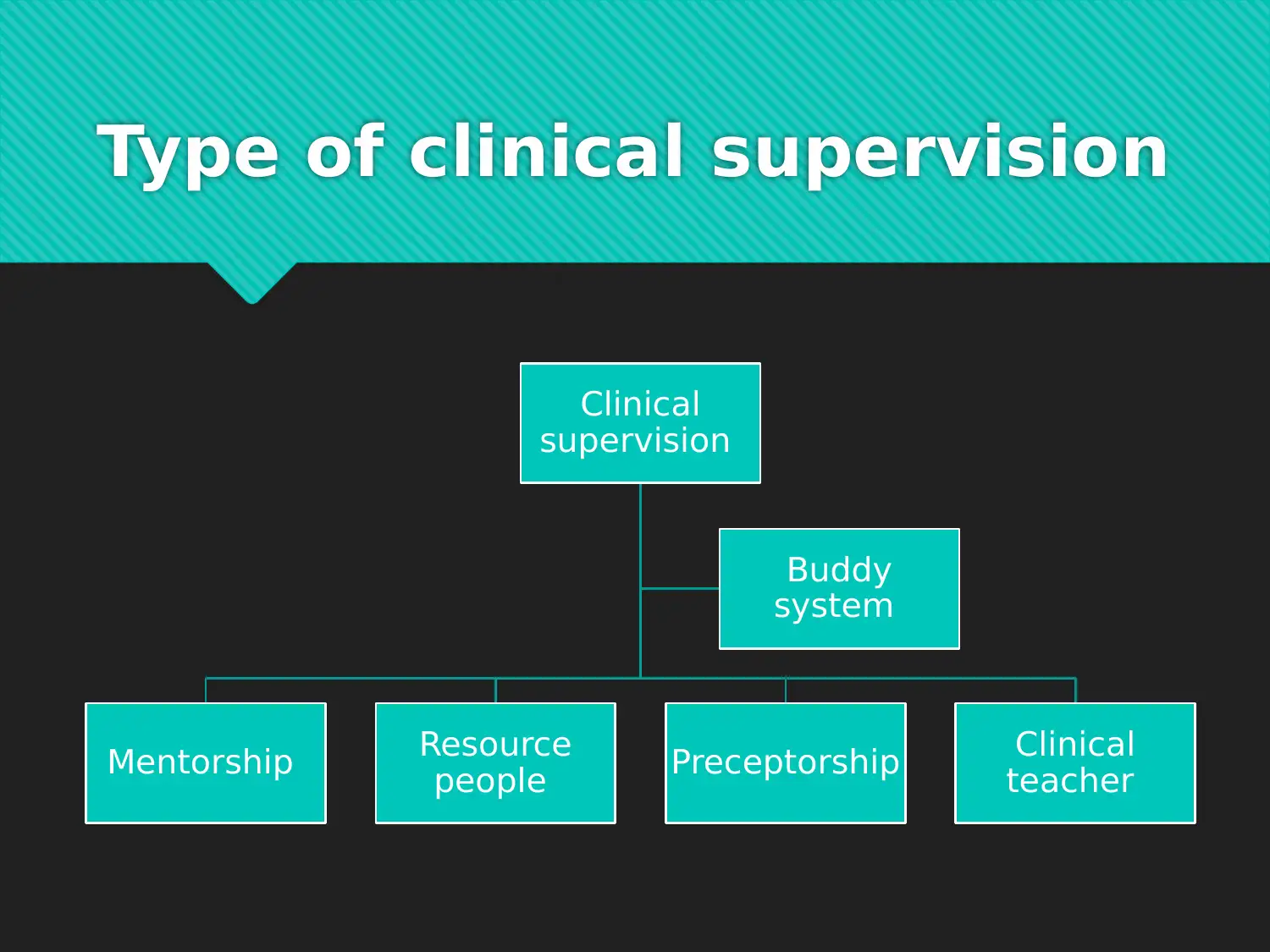
Type of clinical supervision
Clinical
supervision
Mentorship Resource
people Preceptorship Clinical
teacher
Buddy
system
Clinical
supervision
Mentorship Resource
people Preceptorship Clinical
teacher
Buddy
system
⊘ This is a preview!⊘
Do you want full access?
Subscribe today to unlock all pages.

Trusted by 1+ million students worldwide
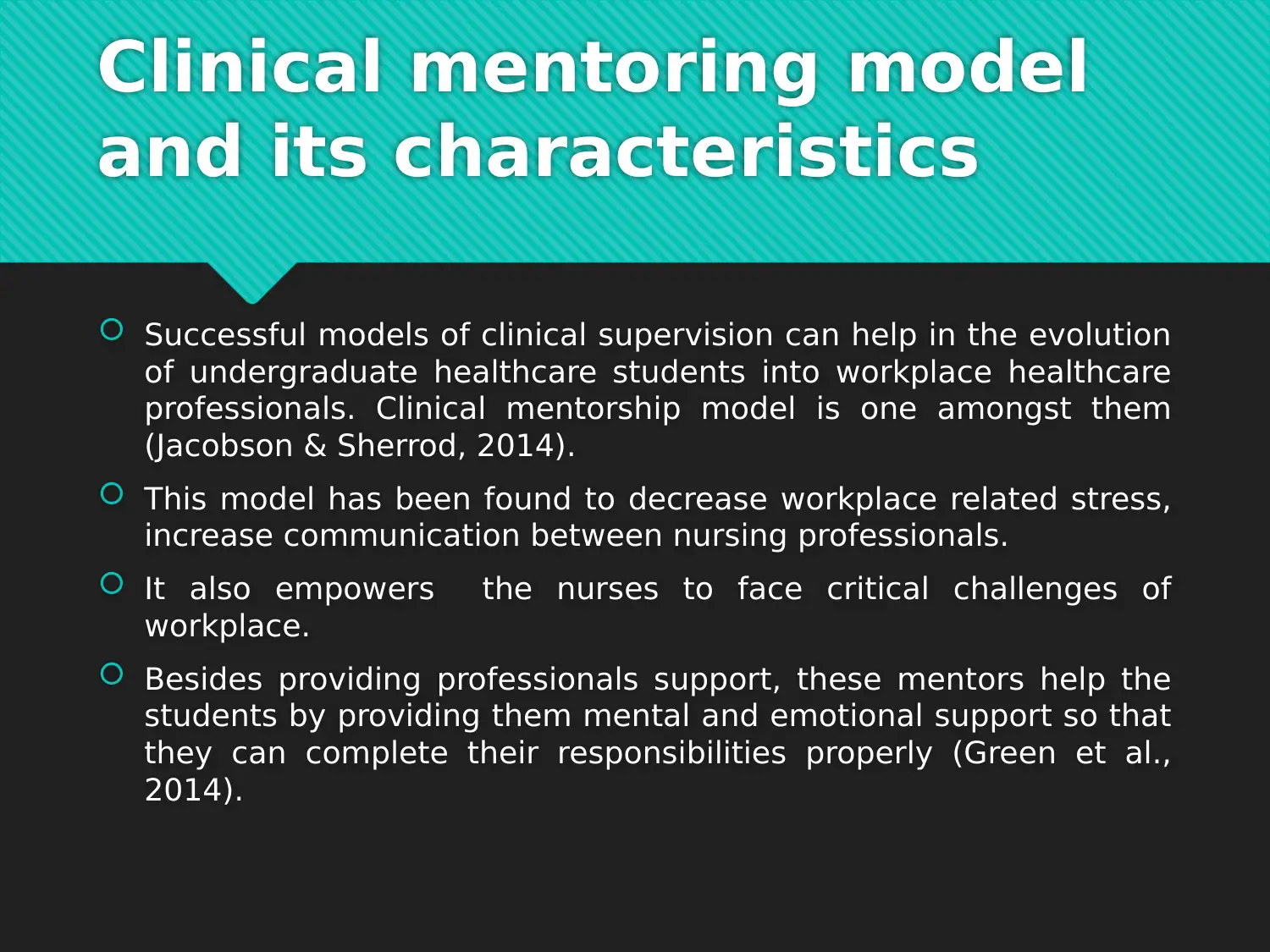
Clinical mentoring model
and its characteristics
Successful models of clinical supervision can help in the evolution
of undergraduate healthcare students into workplace healthcare
professionals. Clinical mentorship model is one amongst them
(Jacobson & Sherrod, 2014).
This model has been found to decrease workplace related stress,
increase communication between nursing professionals.
It also empowers the nurses to face critical challenges of
workplace.
Besides providing professionals support, these mentors help the
students by providing them mental and emotional support so that
they can complete their responsibilities properly (Green et al.,
2014).
and its characteristics
Successful models of clinical supervision can help in the evolution
of undergraduate healthcare students into workplace healthcare
professionals. Clinical mentorship model is one amongst them
(Jacobson & Sherrod, 2014).
This model has been found to decrease workplace related stress,
increase communication between nursing professionals.
It also empowers the nurses to face critical challenges of
workplace.
Besides providing professionals support, these mentors help the
students by providing them mental and emotional support so that
they can complete their responsibilities properly (Green et al.,
2014).
Paraphrase This Document
Need a fresh take? Get an instant paraphrase of this document with our AI Paraphraser
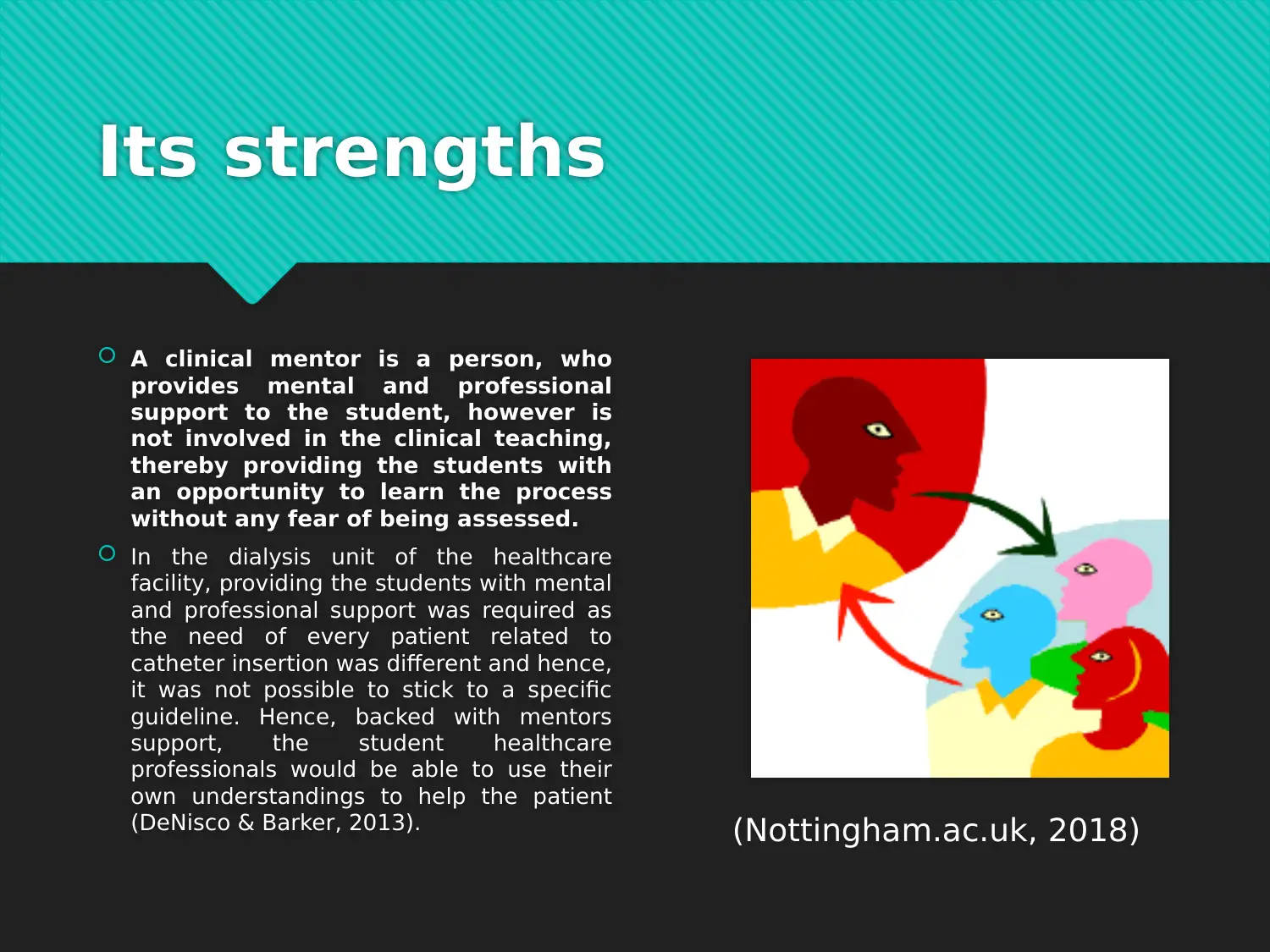
Its strengths
A clinical mentor is a person, who
provides mental and professional
support to the student, however is
not involved in the clinical teaching,
thereby providing the students with
an opportunity to learn the process
without any fear of being assessed.
In the dialysis unit of the healthcare
facility, providing the students with mental
and professional support was required as
the need of every patient related to
catheter insertion was different and hence,
it was not possible to stick to a specific
guideline. Hence, backed with mentors
support, the student healthcare
professionals would be able to use their
own understandings to help the patient
(DeNisco & Barker, 2013). (Nottingham.ac.uk, 2018)
A clinical mentor is a person, who
provides mental and professional
support to the student, however is
not involved in the clinical teaching,
thereby providing the students with
an opportunity to learn the process
without any fear of being assessed.
In the dialysis unit of the healthcare
facility, providing the students with mental
and professional support was required as
the need of every patient related to
catheter insertion was different and hence,
it was not possible to stick to a specific
guideline. Hence, backed with mentors
support, the student healthcare
professionals would be able to use their
own understandings to help the patient
(DeNisco & Barker, 2013). (Nottingham.ac.uk, 2018)
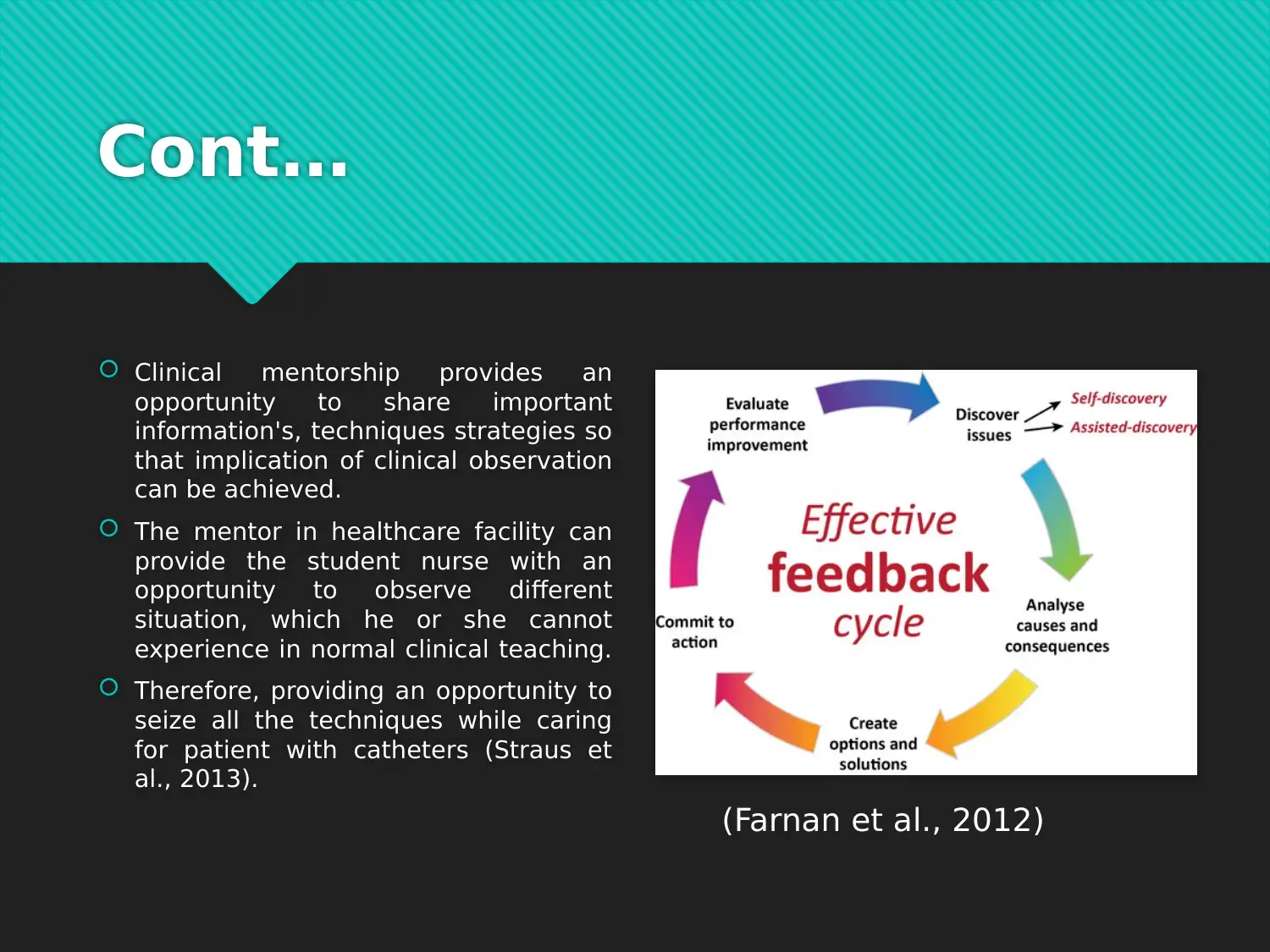
Cont…
Clinical mentorship provides an
opportunity to share important
information's, techniques strategies so
that implication of clinical observation
can be achieved.
The mentor in healthcare facility can
provide the student nurse with an
opportunity to observe different
situation, which he or she cannot
experience in normal clinical teaching.
Therefore, providing an opportunity to
seize all the techniques while caring
for patient with catheters (Straus et
al., 2013).
(Farnan et al., 2012)
Clinical mentorship provides an
opportunity to share important
information's, techniques strategies so
that implication of clinical observation
can be achieved.
The mentor in healthcare facility can
provide the student nurse with an
opportunity to observe different
situation, which he or she cannot
experience in normal clinical teaching.
Therefore, providing an opportunity to
seize all the techniques while caring
for patient with catheters (Straus et
al., 2013).
(Farnan et al., 2012)
⊘ This is a preview!⊘
Do you want full access?
Subscribe today to unlock all pages.

Trusted by 1+ million students worldwide

Its limitations
As mentioned, mentors are not
clinical teachers, they do not
convey the mistakes of student
nurses to clinical teachers,
limiting the scope of
improvement (de Swardt, van
Rensburg & Oosthuizen, 2017).
Further, mentors fails to provide
a clear ideation to any
healthcare scenario, as their role
is to provide a general idea to
the student nurses to provide
them the space to implement
their critical thinking.
As mentioned, mentors are not
clinical teachers, they do not
convey the mistakes of student
nurses to clinical teachers,
limiting the scope of
improvement (de Swardt, van
Rensburg & Oosthuizen, 2017).
Further, mentors fails to provide
a clear ideation to any
healthcare scenario, as their role
is to provide a general idea to
the student nurses to provide
them the space to implement
their critical thinking.
Paraphrase This Document
Need a fresh take? Get an instant paraphrase of this document with our AI Paraphraser
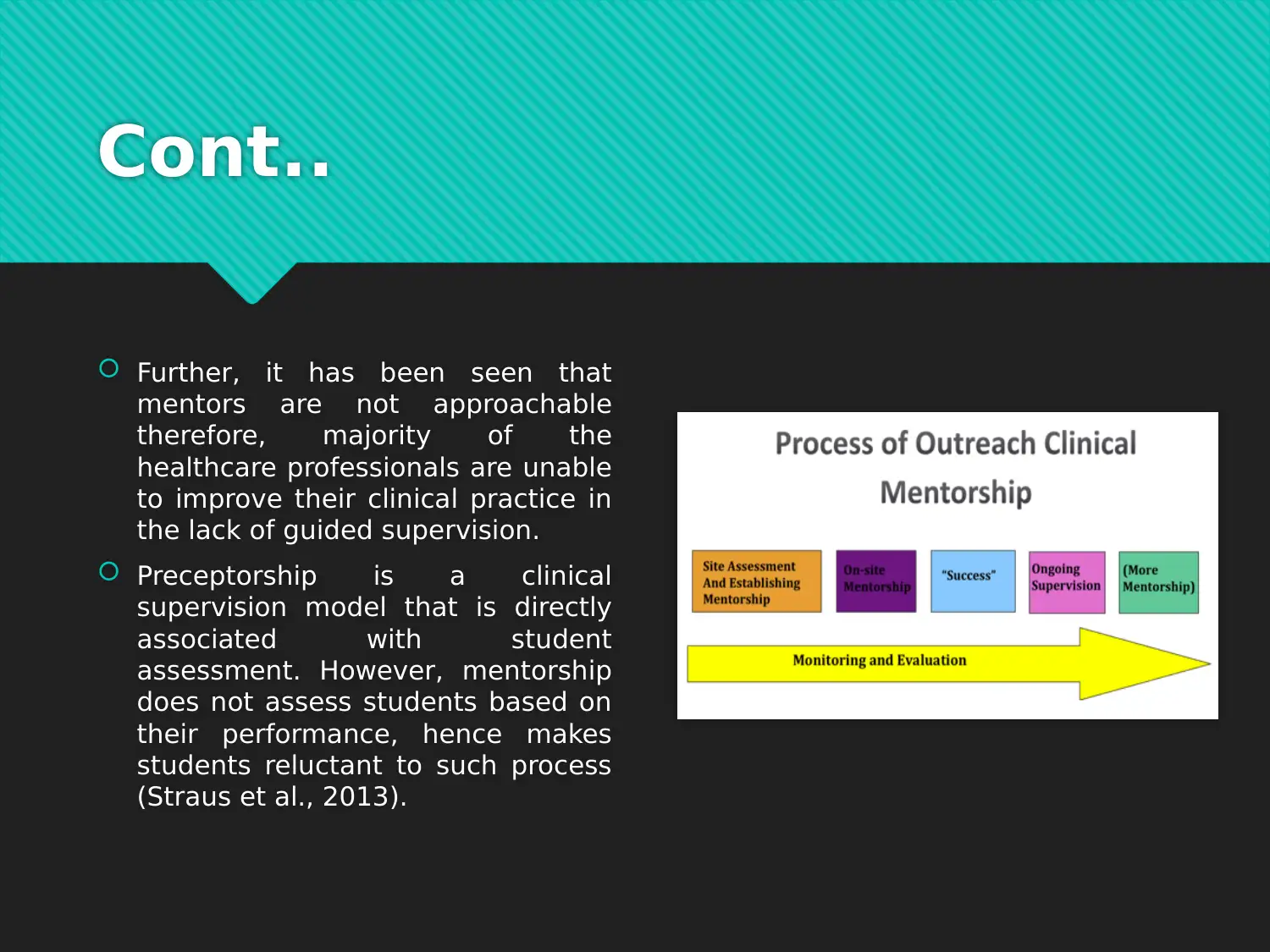
Cont..
Further, it has been seen that
mentors are not approachable
therefore, majority of the
healthcare professionals are unable
to improve their clinical practice in
the lack of guided supervision.
Preceptorship is a clinical
supervision model that is directly
associated with student
assessment. However, mentorship
does not assess students based on
their performance, hence makes
students reluctant to such process
(Straus et al., 2013).
Further, it has been seen that
mentors are not approachable
therefore, majority of the
healthcare professionals are unable
to improve their clinical practice in
the lack of guided supervision.
Preceptorship is a clinical
supervision model that is directly
associated with student
assessment. However, mentorship
does not assess students based on
their performance, hence makes
students reluctant to such process
(Straus et al., 2013).
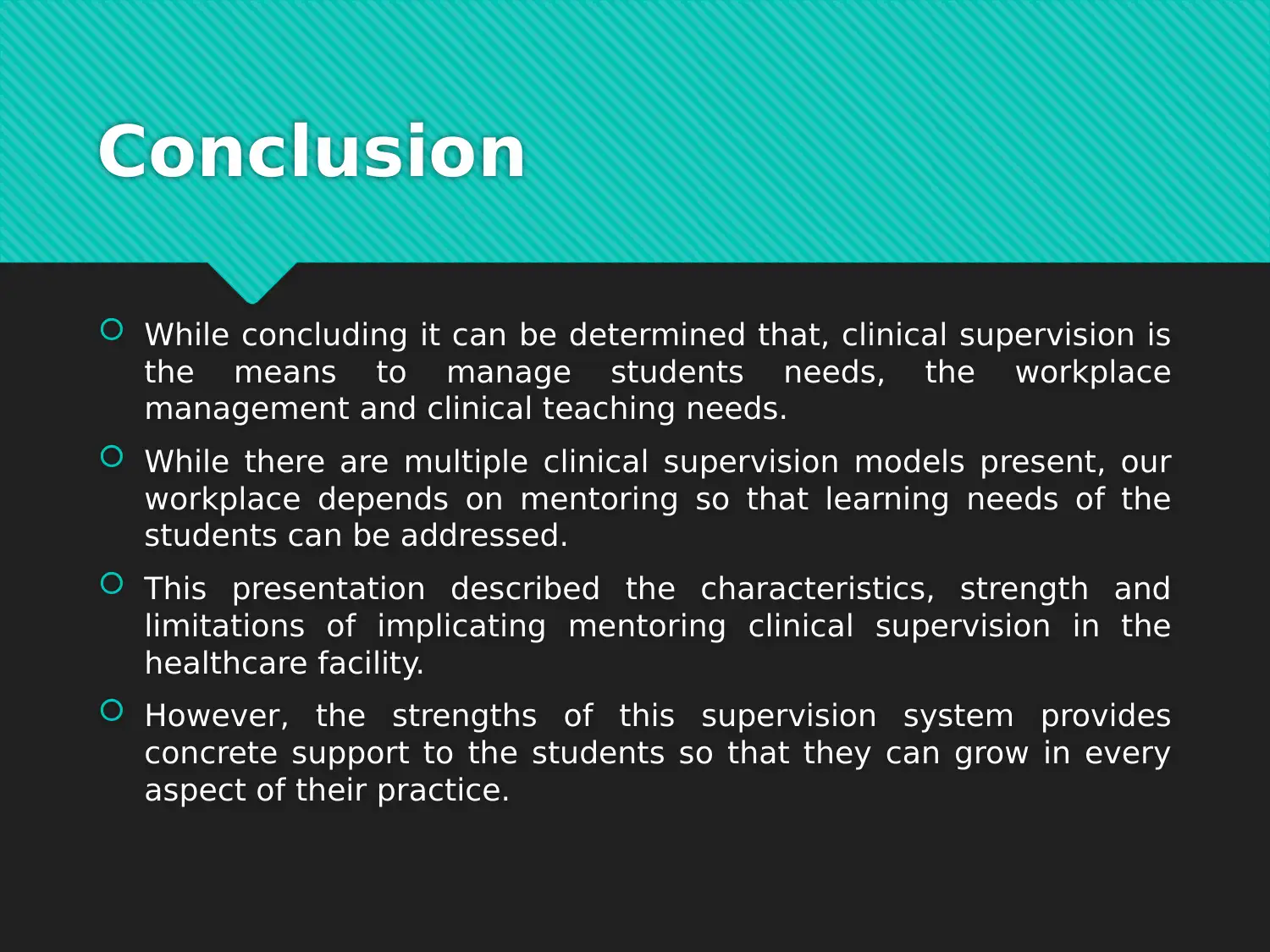
Conclusion
While concluding it can be determined that, clinical supervision is
the means to manage students needs, the workplace
management and clinical teaching needs.
While there are multiple clinical supervision models present, our
workplace depends on mentoring so that learning needs of the
students can be addressed.
This presentation described the characteristics, strength and
limitations of implicating mentoring clinical supervision in the
healthcare facility.
However, the strengths of this supervision system provides
concrete support to the students so that they can grow in every
aspect of their practice.
While concluding it can be determined that, clinical supervision is
the means to manage students needs, the workplace
management and clinical teaching needs.
While there are multiple clinical supervision models present, our
workplace depends on mentoring so that learning needs of the
students can be addressed.
This presentation described the characteristics, strength and
limitations of implicating mentoring clinical supervision in the
healthcare facility.
However, the strengths of this supervision system provides
concrete support to the students so that they can grow in every
aspect of their practice.
⊘ This is a preview!⊘
Do you want full access?
Subscribe today to unlock all pages.

Trusted by 1+ million students worldwide
1 out of 14
Related Documents
Your All-in-One AI-Powered Toolkit for Academic Success.
+13062052269
info@desklib.com
Available 24*7 on WhatsApp / Email
![[object Object]](/_next/static/media/star-bottom.7253800d.svg)
Unlock your academic potential
Copyright © 2020–2025 A2Z Services. All Rights Reserved. Developed and managed by ZUCOL.





